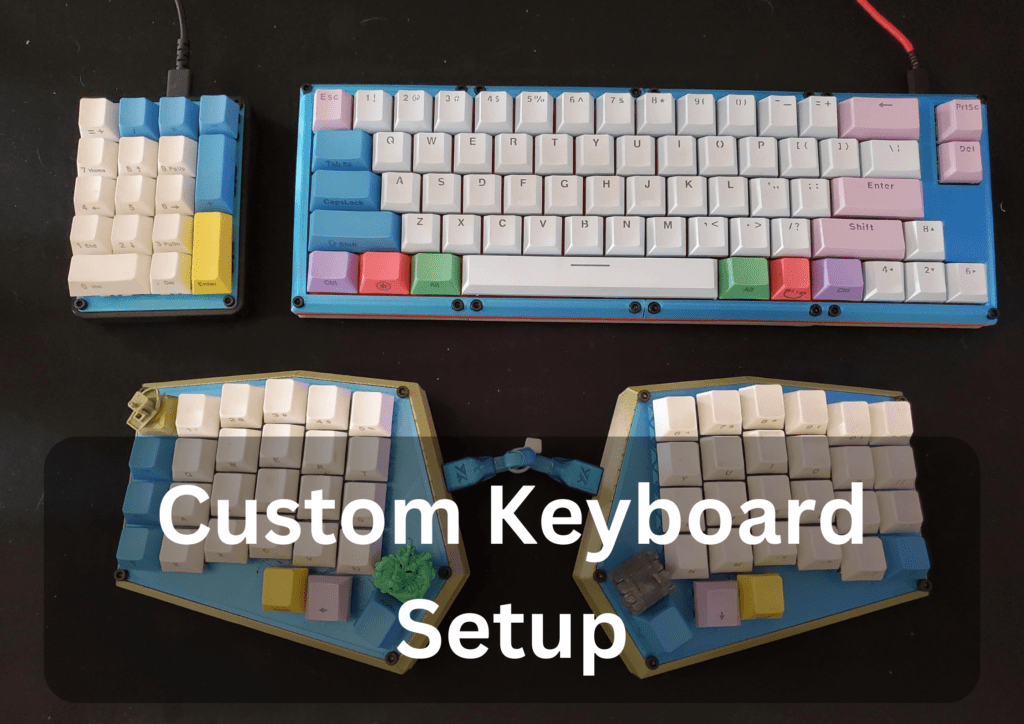In our fast-paced digital age, where technology constantly evolves, personalization has become the key to enhancing user experiences. One area where this customization trend has gained significant traction is in the realm of keyboards. Custom keyboard setups have become a popular choice among users, providing them with a tailored typing experience that goes beyond the standard offerings. But what exactly does custom keyboard setup entail, and why has it become a growing trend in the tech industry?

Contents
- 1 Exploring the Significance of a Custom Keyboard Setup
- 2 1.Understanding Custom Keyboard Components
- 3 2.Custom Keyboard Setup Process
- 4 3. Popular Custom Keyboard Configurations
- 5 4.Best Practices for Maintaining Custom Keyboards
- 6 5.Conclusion: Embracing Personalization in Keyboard Technology
- 7 Frequently Asked Questions (FAQs)
Exploring the Significance of a Custom Keyboard Setup
Custom keyboard setup refers to the process of assembling and configuring a keyboard according to an individual’s preferences and needs. This includes choosing specific components, keycap designs, and switch types to create a unique typing interface.
The importance of custom keyboard setup lies in its ability to enhance typing efficiency, comfort, and aesthetics. Unlike generic keyboards, customized ones allow users to optimize their typing experience, leading to improved productivity and overall satisfaction.
i. Benefits of Customizing Keyboards for Users
The benefits of customizing keyboards are multifaceted. Firstly, personalized keyboards cater to the ergonomic needs of users, ensuring that they can type comfortably for extended periods without strain. Secondly, customization allows users to create shortcuts and macros tailored to their specific tasks, whether it’s gaming, programming, or multimedia editing. This level of customization enhances efficiency and workflow, making tasks easier and more enjoyable.
ii. Growing Trend in the Tech Industry
The tech industry has witnessed a significant rise in the demand for custom keyboard setups. More users are recognizing the limitations of generic keyboards and are seeking alternatives that align with their unique requirements. Additionally, the availability of diverse components, from mechanical switches to RGB lighting options, has fueled this trend.
As a result, manufacturers and enthusiasts alike are investing in creating innovative and customizable keyboard solutions, driving the growth of this trend.

1.Understanding Custom Keyboard Components
To delve deeper into the world of custom keyboard setups, it’s essential to understand the key components that contribute to their customization.
i. Mechanical vs. Membrane Keyboards: Choosing the Right Base
At the core of every keyboard setup is the choice between mechanical and membrane keyboards. Mechanical keyboards use individual mechanical switches for each key, providing tactile feedback and a satisfying typing experience. On the other hand, membrane keyboards use pressure pads beneath the keys, offering a quieter but less tactile typing experience.
The choice between the two depends on user preference, with mechanical keyboards being favored by enthusiasts for their durability and responsiveness.
ii. Keycap Materials and Designs: Personalizing the Look and Feel
Keycaps, the covers placed on top of switches, come in various materials and designs. From ABS (Acrylonitrile Butadiene Styrene) to PBT (Polybutylene Terephthalate), each material has its unique texture and durability. Additionally, keycaps come in different profiles, such as SA, DSA, and Cherry, each offering a distinct feel while typing. Users can choose keycaps that not only complement their typing style but also enhance the overall aesthetics of the keyboard.
iii. Switch Types: Cherry MX, Razer, and More
Switch types play a pivotal role in determining the typing experience. Cherry MX switches are renowned for their smooth keystrokes and audible feedback, making them a popular choice among enthusiasts. Razer switches, developed by the gaming peripherals company Razer Inc., are specifically designed for gamers, offering rapid actuation for quick and precise keystrokes. Other switch options, such as Gateron and Kailh, cater to different preferences, allowing users to customize their typing experience further.
iv. Backlighting and RGB Options: Enhancing Aesthetics and Functionality
Backlighting and RGB (Red, Green, Blue) options are not merely decorative elements but also functional features of custom keyboards. Backlit keyboards enhance visibility in low-light environments, ensuring users can type comfortably at any time of the day. RGB keyboards take it a step further by allowing users to customize individual key colors and create dynamic lighting effects.
These options not only enhance the keyboard’s aesthetics but also contribute to the overall ambiance of the user’s workspace.

2.Custom Keyboard Setup Process
Now that we have explored the fundamental components of custom keyboards, let’s dive into the process of setting up a customized keyboard.
i. Step-by-Step Guide to Building a Custom Keyboard
a. Choosing the Right Components
The first step in building a custom keyboard is selecting the components. This includes choosing the base (mechanical or membrane), specific switches, keycap materials, and designs. Users can opt for pre-assembled kits or select individual components based on their preferences and budget.
b. Assembling the Keyboard
Once the components are acquired, assembling the keyboard is the next crucial step. Users need to carefully place the switches into the keyboard PCB (Printed Circuit Board) and secure them in place. Keycaps are then placed on top of the switches, ensuring they align correctly for a seamless typing experience. Attention to detail during this step is essential to prevent any issues with keystrokes or key stability.
c. Programming and Key Mapping
After the physical assembly is complete, users can program and map the keys according to their specific needs. This step involves configuring shortcuts, macros, and special functions for individual keys. Customization software, provided by keyboard manufacturers or enthusiasts’ communities, allows users to assign specific actions to keys, enabling personalized and efficient typing experiences.
ii. Troubleshooting Common Issues: Ensuring Smooth Functionality
During the setup process, users may encounter common issues such as unresponsive keys, inconsistent keystrokes, or lighting malfunctions. Troubleshooting these problems involves checking the connections, ensuring switches are properly seated, and verifying the configuration settings in the customization software. Online communities and forums are valuable resources for troubleshooting, providing users with solutions and expert advice.
iii. Customization Software: Exploring Options for Different Operating Systems
Customization software plays a central role in custom keyboard setups, offering users a user-friendly interface to configure their keyboards. Manufacturers provide software compatible with various operating systems, including Windows, macOS, and Linux. These programs allow users to create intricate lighting effects, program complex macros, and fine-tune key sensitivity. Exploring the features of customization software enhances the overall customization experience, empowering users to make the most of their custom keyboards.

3. Popular Custom Keyboard Configurations
Custom keyboards cater to a diverse range of user needs, from gaming and programming to multimedia editing and ergonomic requirements.
i. Gaming Setups: Optimizing Key Layouts for Gaming Performance
Gaming setups focus on optimizing key layouts for specific gaming genres. For example, in first-person shooter games, WASD keys are crucial for movement, while MMO (Massively Multiplayer Online) games may require a multitude of customizable macro keys. Custom keyboards for gaming often feature tactile and responsive switches, ensuring quick and accurate keystrokes during intense gaming sessions.
Additionally, RGB lighting can be synchronized with in-game events, enhancing the gaming atmosphere.
ii. Programming and Coding: Macros and Shortcuts for Efficiency
Programmers and coders rely on efficiency and speed when typing long lines of code. Custom keyboards for programming often include dedicated macro keys that can be programmed to input frequently used code snippets or commands. This reduces the need for repetitive typing, saving time and minimizing the risk of errors. Moreover, customizable shortcuts for common programming functions streamline the coding process, allowing developers to focus on their creativity and problem-solving skills.
iii. Multimedia and Design: Custom Keys for Editing Software
Professionals in multimedia and design industries, such as video editing, graphic design, and 3D modeling, benefit from custom keyboards tailored to their specific software. Custom keys can be programmed to execute functions like cut, copy, paste, and undo, eliminating the need to navigate through complex menus. Additionally, shortcuts for tools and filters can be assigned to keys, enabling seamless editing workflows. Custom keyboards in these fields enhance productivity and precision, empowering users to bring their creative visions to life.
iv. Ergonomic Keyboards: Tailoring Layouts for Comfort and Health
Ergonomic keyboards are designed with user comfort and health in mind. These keyboards feature unique layouts, split designs, and tenting angles to reduce strain on the wrists and hands. Keys are often arranged in a more natural and ergonomic position, allowing users to type for extended periods without discomfort.
Customization options for ergonomic keyboards include adjustable key switches, allowing users to select switches with the optimal actuation force for their typing style. By tailoring the keyboard layout to the user’s body mechanics, ergonomic keyboards promote long-term typing comfort and overall well-being.

4.Best Practices for Maintaining Custom Keyboards
Custom keyboards, like any other electronic device, require regular maintenance to ensure longevity and optimal performance.
i. Cleaning and Maintenance Tips: Prolonging the Lifespan of Components
Proper cleaning is essential to prevent dust and debris from accumulating between the keys, which can hinder keystrokes and affect overall performance. Users can use compressed air to blow out dust or a small brush to gently remove debris. Regular cleaning not only maintains the keyboard’s functionality but also preserves the appearance of keycaps and switches. Additionally, users should avoid eating or drinking near the keyboard to prevent spills that could damage internal components.
ii. Upgrading and Modifying: Keeping Up with Technological Advancements
The tech industry is constantly evolving, with new keyboard components and technologies emerging regularly. Enthusiasts who enjoy customizing their setups often look for opportunities to upgrade their keyboards with the latest switches, keycap designs, or backlighting options. Staying informed about new developments in the market allows users to make informed decisions when upgrading their keyboards. Upgrading not only enhances the typing experience but also introduces users to the latest innovations in keyboard technology.
iii. Community Forums and Resources: Staying Updated and Getting Support
Being part of online communities and forums dedicated to custom keyboards provides users with a valuable source of information, support, and inspiration. These platforms allow users to share their setups, ask for advice, and learn from the experiences of others. Engaging with the community fosters a sense of camaraderie among enthusiasts, creating a space where knowledge is freely exchanged.
Additionally, these communities often host group buys for unique and limited-edition keyboard components, giving users access to exclusive products that further enhance their setups.

5.Conclusion: Embracing Personalization in Keyboard Technology
In conclusion, the world of custom keyboard setups offers endless possibilities for users seeking a personalized and optimized typing experience. From choosing the right components and assembling the keyboard to programming custom keys and exploring RGB lighting effects, enthusiasts can create keyboards that align perfectly with their preferences and needs.
i. Recap of Custom Keyboard Benefits and Possibilities
Custom keyboards provide users with ergonomic designs, efficient shortcuts, and visually stunning aesthetics. The ability to tailor the typing experience to specific tasks, whether it’s gaming, programming, or multimedia editing, enhances productivity and enjoyment. Moreover, the sense of ownership and creativity associated with customizing keyboards fosters a deep appreciation for technology.
ii. Encouraging Readers to Explore Custom Keyboard Setup
For readers intrigued by the world of custom keyboard setups, the journey begins with exploration. Researching different components, reading user reviews, and joining online communities can provide valuable insights and inspiration. Trying out different switches, keycap designs, and layouts allows users to discover what works best for them. Embracing the customization process not only enhances typing comfort but also reflects individual style and preferences.
iii. Call-to-Action: Contact Us for Expert Assistance in Custom Keyboard Configuration
As you embark on your custom keyboard journey, our expert team is here to assist you every step of the way. Whether you need guidance in choosing the right components, programming custom keys, or troubleshooting issues, our knowledgeable professionals are dedicated to ensuring your custom keyboard setup exceeds your expectations. Contact us today to transform your typing experience and embrace the limitless possibilities of personalized keyboard technology.
For more information on keyboards, check out How to Build a Custom Mechanical Keyboard, Master the art of Razer keyboard lighting, Expert Guide: How to Replace Keycaps on a Keyboard Effortlessly! & Most Expensive Keyboards Luxury at Your Fingertips. If you’re interested in a Level Up Your Game Ultimate Gaming Keyboard Setup explore our guide here.
Frequently Asked Questions (FAQs)
Q1.How do you configure custom keyboard keys?
Configuring custom keyboard keys involves using specific software provided by keyboard manufacturers or enthusiasts’ communities. First, you need to install the customization software compatible with your operating system. Once installed, open the software and select the key you want to configure.
You can assign various functions, macros, or shortcuts to the selected key through the software’s intuitive interface. After customization, save the changes, and your custom keyboard keys are configured and ready to use.
Q2.Is there a way to make a custom keyboard?
Yes, there are several ways to make a custom keyboard. Enthusiasts often purchase individual components such as switches, keycaps, and PCBs (Printed Circuit Boards) from specialized online stores. They then assemble these components using soldering techniques or hot-swappable sockets.
Additionally, there are DIY (Do-It-Yourself) kits available that provide all the necessary components and step-by-step instructions for assembling a custom keyboard. Online communities and forums are excellent resources for beginners, offering support and guidance throughout the process.
Q3.How do I create my own keyboard layout?
Creating your own keyboard layout involves customizing the arrangement of keys to suit your preferences. To do this, you can use software tools specifically designed for keyboard layout customization. These tools allow you to remap keys, change key functions, and create macros.
Start by opening the software and selecting the keys you want to modify. Then, assign the desired functions or characters to each key. Once you have configured the layout to your satisfaction, save the changes, and the customized keyboard layout will be applied to your device.
Q4.What is the website for custom keyboard layout?
There isn’t a single specific website for custom keyboard layouts, as the customization process often involves using software applications rather than visiting a particular website. However, there are online communities, forums, and resources dedicated to custom keyboards where enthusiasts share their layouts and configurations.
Websites like Reddit’s /MechanicalKeyboards, Geekhack, and Deskthority host discussions, guides, and user-created layouts that can inspire your own custom keyboard layout designs. Additionally, some keyboard manufacturers offer downloadable software on their official websites, allowing users to create and share custom keyboard layouts.










